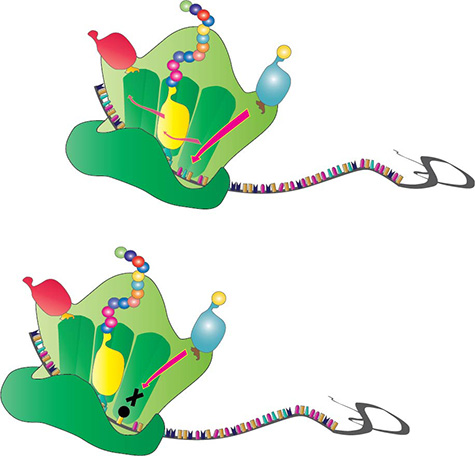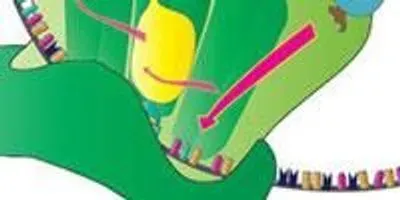 The Zaher lab has found that that oxidative damage to a single base (bold X) on a messenger RNA (the jagged ribbon) can jam the cellular nanomachine (green) that translates the mRNA into protein (ribbon into beads).HANI ZAHERDamage to DNA is an issue for all cells, particularly in cancer, where the mechanisms that repair damage typically fail. The same agents that damage DNA also damage its sister molecule messenger RNA (mRNA), which ferries transcripts of the genes to the tens of thousands of ribosomes in each cell. But little attention has been paid to this damage.
The Zaher lab has found that that oxidative damage to a single base (bold X) on a messenger RNA (the jagged ribbon) can jam the cellular nanomachine (green) that translates the mRNA into protein (ribbon into beads).HANI ZAHERDamage to DNA is an issue for all cells, particularly in cancer, where the mechanisms that repair damage typically fail. The same agents that damage DNA also damage its sister molecule messenger RNA (mRNA), which ferries transcripts of the genes to the tens of thousands of ribosomes in each cell. But little attention has been paid to this damage.
“Everybody thought, ‘Why care about the messenger RNA? These molecules have high turnover rates and are quickly degraded, so what does it matter if one is damaged?’” said Hani Zaher, PhD, assistant professor of biology in Arts & Sciences at Washington University in St. Louis.
“In organisms like E. coli or yeast, that’s probably true,” Zaher said. “You don’t have to worry about mRNA because it turns over really fast. But in neurons you can’t use that argument because an mRNA can persist, in some cases for days. And if that mRNA is really damaged it can become a big problem.”
“There may be cases where messenger RNA is just as important as DNA,” said Carrie Simms, PhD, a postdoctoral associate in Zaher’s lab. “Clearly oxidative damage to RNA is somehow involved in neurodegenerative diseases, such as Alzheimer’s and ALS. It’s not necessarily causing the disease; it may just be some sort of byproduct; but it’s in the mix.”
“Under normal conditions only about 1 percent of the cellular mRNAs are oxidized,” Zaher said, “but if you have oxidative stress, for whatever reason, a higher percentage can be damaged.
One of the hallmarks of Alzheimer’s is oxidative stress, and studies have shown that in people with advanced Alzheimer’s, half of the RNA molecules in the neurons may be oxidized.
In the November 13 issue of Cell Reports, Zaher, Simms and their colleagues report that when they fed oxidized mRNA to ribosomes, the nanomachines that convert mRNA to protein, the ribosomes jammed and stopped.
A stuck ribosome could be rescued by factors that released it from the mRNA and chewed up the damaged transcipt. But if the factors involved in this quality-control system were absent, damaged mRNA accumulated in the cell, just as it does in Alzheimer’s.
A surprise
The three cellular processes essential to life—making copies of DNA, copying DNA into mRNA, and translating the mRNA into protein—have been penalized for billions of years by evolution, are astonishingly accurate, because evolution has heavily penalized any sloppiness.
Errors in DNA copying occur only once every billion events. When DNA is transcribed to mRNA, there is a mistake about once every ten thousand events .and when the mRNA is translated to protein, there might be an error once every thousand events.
To test the robustness of translation, the Zaher lab set out to break it, by giving faulty mRNA transcripts to ribosomes. They damaged one letter in a three-letter mRNA coding unit, oxidizing a G (the base guanine), to create what is called 8-oxo-G.
“We chose this oxidized base,” he said,” because we knew that when DNA is copied, an oxidized G causes a mistake. Instead of pairing with a C, as it normally would, 8-oxo-G will pair with an A.”
He thought the ribosome would read the three-letter codon C[8-oxo-G]C not as CGC but rather as CAC and conseqeuntly put the wrong amino acid in the protein chain it was making.
But when 8-oxo-G was added to a soup that contained all the factors needed to translate mRNA into protein, something surprising happened.
“We expected that we might get aberrant proteins,“ Simms said. “But the ribosome didn’t make mistakes. It just stopped. It couldn’t deal with the mRNA at all”
The scientsts could tell it was stuck because levels of the protein the faulty mRNA encodes plummeted.
To make sure it was the presence rather than the position of the 8-oxo-G that mattered, Simms made mRNAs with the 8-oxo-G in each of the three positions of the three-letter coding unit. Each time the ribosome stalled.
No-go decay
Knowing they had found something interesting, the scientists upped their game. Simms built a longer 300-nucleotide mRNA to use as a probe. And instead of adding the damaged mRNA to a reconstituted bacterial system, she put it in extracts of plant and animal cells.
“We couldn’t look at ribosomes in the extracts,” Simms said, “but we could look at the proteins they made. They made short proteins, exactly the length you’d expect if the ribosome were stopping at the damaged base. “
A single mRNA typically has several ribosomes traveling along it, all simultaneously translating this transcript into protein. When the first ribosome stops, the others pile up behind it.
“You get this small product that is telling you the ribosome cannot go through the 8-oxo-G and then you get even smaller products that are telling you there are multiple ribosomes stuck behind the first ribosome. So the backed up ribosomes make a ladder of peptides,” Zaher said.
“This is a problem,” he said. “Among other things, the ribosome is an expensive machine that the cell has invested a lot of energy in making, and now it’s stuck on an mRNA. You need those ribosomes back.”
Fortunately ribosomes have three quality-control systems that keep watch for errors in the mRNA and rescue the ribosome if spot serious mistakes. One of these systems is “no-go decay.” When ribosomes are stuck and can’t go forward, they recruit factors that come in to pry open the ribosome, chew up the mRNA and add a tag to the defective peptide that marks it for degradation.”
But no-go decay was originally discovered by throwing artificial roadblocks in the ribosome’s way: mRNAs with large hairpin turns in them that the ribosome could not unwind or plow through.
“Four billion years of evolution has made sure your genome does not have sequences that make hairpins, so these are clearly not the intended targets for no-go decay,” Zaher said.
Were oxidized mRNAs the target?
Not just a go-between
To find out, the scientists turned to yeast cells. If the yeast’s ribosomes jammed on the oxidized mRNA but were rescued by no-go decay, very little damaged mRNA would accumulate in the cell. This proved to be the case.
Simms then deleted the gene for a factor that releases the ribosome from the mRNA when it jams. In these knockout yeast the level of oxidized mRNA went up. Then she deleted the gene for a factor that is recruited to degrade the mRNA after the ribosome is released, and again the level of oxidized mRNA rose. Without no-go decay, the cells were clearly in trouble.
“The system that translates mRNA into protein is highly conserved, so what’s true for yeast is probably true for people as well,” said Zaher.
Is oxidized mRNA implicated in disease? Science recently published work showing that mice with a double defect in their translation system have severe neurodegenerative disease, Zaher said.
One of the defects is an error in mouse t-RNA (another type of RNA involved in translation) that stalls the ribosome and the other is a defect in the system that rescues the ribosome when it stalls. Mice with both defects begin to have trouble walking and die in a few weeks, Zaher said.
‘People have always said that mRNA is just the go-between,” said Simms. “DNA and protein are the key factors and RNA is just this guy that gets made and then turned over and is not all that important. But we’re seeing that it is important; far more important than we had realized.”
“In retrospect it’s clear that mRNA matters,” said Zaher. “That’s why we have evolved three independent pathways to make sure that broken mRNAs don’t hang around for long.”
Damage to DNA is an issue for all cells, particularly in cancer, where the mechanisms that repair damage typically fail. The same agents that damage DNA also damage its sister molecule messenger RNA (mRNA), which ferries transcripts of the genes to the tens of thousands of ribosomes in each cell. But little attention has been paid to this damage.
“Everybody thought, ‘Why care about the messenger RNA? These molecules have high turnover rates and are quickly degraded, so what does it matter if one is damaged?’” said Hani Zaher, PhD, assistant professor of biology in Arts & Sciences at Washington University in St. Louis.
“In organisms like E. coli or yeast, that’s probably true,” Zaher said. “You don’t have to worry about mRNA because it turns over really fast. But in neurons you can’t use that argument because an mRNA can persist, in some cases for days. And if that mRNA is really damaged it can become a big problem.”
“There may be cases where messenger RNA is just as important as DNA,” said Carrie Simms, PhD, a postdoctoral associate in Zaher’s lab. “Clearly oxidative damage to RNA is somehow involved in neurodegenerative diseases, such as Alzheimer’s and ALS. It’s not necessarily causing the disease; it may just be some sort of byproduct; but it’s in the mix.”
“Under normal conditions only about 1 percent of the cellular mRNAs are oxidized,” Zaher said, “but if you have oxidative stress, for whatever reason, a higher percentage can be damaged.
To continue reading this article, sign up for FREE to

Membership is FREE and provides you with instant access to eNewsletters, digital publications, article archives, and more.











